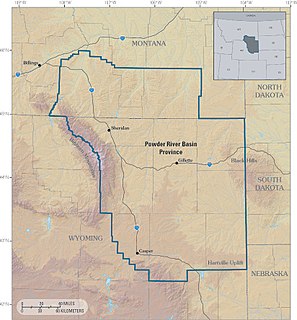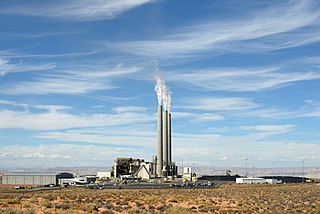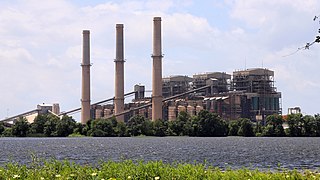
The Powder River Basin is a geologic structural basin in southeast Montana and northeast Wyoming, about 120 miles (190 km) east to west and 200 miles (320 km) north to south, known for its extensive coal reserves. The former hunting grounds of the Oglala Lakota, the area is very sparsely populated and is known for its rolling grasslands and semiarid climate.

A fossil fuel power station is a thermal power station which burns a fossil fuel, such as coal or natural gas, to produce electricity. Fossil fuel power stations have machinery to convert the heat energy of combustion into mechanical energy, which then operates an electrical generator. The prime mover may be a steam turbine, a gas turbine or, in small plants, a reciprocating gas engine. All plants use the energy extracted from the expansion of a hot gas, either steam or combustion gases. Although different energy conversion methods exist, all thermal power station conversion methods have their efficiency limited by the Carnot efficiency and therefore produce waste heat.

Navajo Generating Station was a 2.25-gigawatt, coal-fired power plant located on the Navajo Nation, near Page, Arizona, United States. This plant provided electrical power to customers in Arizona, Nevada, and California. It also provided the power for pumping Colorado River water for the Central Arizona Project, supplying about 1.5 million acre feet (1.85 km3) of water annually to central and southern Arizona. As of 2017 permission to operate as a conventional coal-fired plant was anticipated until 2017–2019, and to December 22, 2044, if extended. However, in 2017, the utility operators of the power station voted to close the facility when the lease expires in 2019. In March 2019, the Navajo Nation ended efforts to buy the plant and continue running it after the lease expires.

Allegheny Energy was an electric utility headquartered in Greensburg, Pennsylvania. It owned and operated electric generation facilities and delivered electric services to customers in Pennsylvania, West Virginia, Maryland, and Virginia. Allegheny Energy was incorporated in Maryland in 1925 as West Penn Electric Company. One of its predecessor companies dates back to the formation of West Penn Power on January 31, 1907.
Basin Electric Power Cooperative is a wholesale electric generation and transmission cooperative based in North Dakota that provides electricity to 2.8 million customers in nine U.S. states. The roots of the cooperative go back to 1960 when Leland Olds and ten power suppliers created Giant Power Cooperative. Giant Power was first going to be a generation and transmission cooperative, but to keep electricity cheaper for rural customers, Basin Electric Power Cooperative was started in 1961. Today, Basin Electric's power sources include coal, natural gas, hydroelectric, wind, waste heat, and nuclear. The current CEO and General Manager is Paul Sukut. A subsidiary of Basin Electric, Dakota Gasification Company, operates the Great Plains Synfuels Plant, which captures and sequesters nearly 50% of its carbon dioxide emissions in a system developed during the Carter administration. In 2005, the membership of Basin Electric passed a resolution requiring 10 percent of electricity demand to be provided by renewable forms of energy. At the end of 2009, Basin Electric finished construction on a 77 turbine wind energy project.
The Dakota Coal Company, subsidiary of Basin Electric Power Cooperative, is based in Bismarck, North Dakota. It controls the rights to lignite reserves in North Dakota and provides financing for the Freedom Mine north of Beulah, ND. Dakota Coal Company is also responsible for marketing Freedom Mine lignite production. Dakota Coal and The Coteau Properties Co. work closely with their customers to ensure lignite quality doesn't hamper daily plant operations.

The Robert W. Scherer Power Plant is a coal-fired power plant in Juliette, Georgia, just north of Macon, Georgia, in the United States. The plant has four generating units, each capable of producing 930 megawatts, and is the most powerful coal-fired plant in North America. The plant is named after the former chairman and chief executive officer of Georgia Power.

A coal-fired power station or coal power plant is a thermal power station which burns coal to generate electricity. Worldwide there are about 8,500 coal-fired power stations totaling over 2,000 gigawatts capacity. They generate about a third of the world's electricity, but cause many illnesses and early deaths, mainly from air pollution.

Bull Run Fossil Plant, commonly known as Bull Run Steam Plant, is a 889 megawatt (MW), coal-fired electric generating station owned and operated by the Tennessee Valley Authority (TVA). The plant is the only coal fired power plant ever constructed by TVA with one unit, and is expected to close in 2023.

The Chalk Point Generating Station is a 2,647-MWe electricity-generating plant owned by NRG Energy, located near the tiny incorporated town of Eagle Harbor, Maryland, United States, on the Patuxent River.

Centralia Big Hanaford power plant is a major coal-fired power plant supplemented with newer natural-gas-fired units. It is located east of Centralia, Washington, United States in Lewis County. As of 2006, it is the only commercial coal-fired power plant in the State of Washington. A bill signed in 2011 by governor Christine Gregoire, the TransAlta Energy Transition Bill, resulted in one coal boiler being shut down in 2020 and the other by the end of 2025.
Warrick Generating Station is a 755-MWe coal-fired electricity-generating station, located southeast of Newburgh in Warrick County. It sits on the north bank of Ohio River, downstream of the F. B. Culley Generating Station. The plant has four coal-fired, steam-powered turbines with a combined generating capacity of 791 MWe. Alcoa owns three of the four generating stations, which were placed into service in the early 1960s. The largest unit, known as Unit 4, is 323-MWe unit jointly owned by Alcoa and Vectren. This larger unit was placed in operation in 1970.

The Boardman Coal Plant was a coal-fired power plant located in Boardman, Oregon. The facility had a nameplate capacity of 550 megawatts (MWs) and is owned by Portland General Electric. In 2010, the plant was the only remaining coal powered plant in Oregon and received much attention from regional media due to its being the largest single source of greenhouse gas emissions in the state with environmental groups such as the Sierra Club calling for its closing.
Prairie State Energy Campus is a 1,600 megawatt base load, coal-fired, electrical power station and coal mine near Marissa, Illinois southeast of St. Louis, Missouri. Prairie State Energy Campus (PSEC) features low levels of regulated emissions compared to other coal-fired power stations, capturing sulfur from high-sulfur coal mined nearby instead of transporting low-sulfur coal from elsewhere.
The John W. Turk Jr. Coal Plant is a base load 600-megawatt coal-fired power station in Fulton, Arkansas, operated by the American Electric Power subsidiary Southwestern Electric Power Company (SWEPCO). It provides power to customers in Arkansas, Louisiana, and Texas.

Killen Station was a 618 megawatt (MW) dual-fuel power generating facility located east of Wrightsville, Ohio in Adams County, Ohio. The power plant had two units: one coal-fired and one oil-fired. At the time of its closure, it was operated by AES Ohio Generation, a subsidiary of the AES Corporation. The plant began operations in 1982 and ceased generation on May 31, 2018.

Martin Lake Power Plant is a 2,250-megawatt coal power plant located southwest of Tatum, Texas, in Rusk County, Texas. The plant is owned by Luminant. It began operations in 1977. The plant us also served by the Luminant owned Martin Lake Line, shuttling coal from nearby as well as the Powder River Basin in Wyoming via BNSF.
The White Pine Energy Station was a proposed coal-fired power plant that was to be built in White Pine County, Nevada. The plant was to be built in the county's Steptoe Valley, and would be located 34 miles north of the city of Ely. White Pine Energy Associates, LLC, a subsidiary of LS Power, announced the project in February 2004, with plans to begin construction in 2006, with the possibility of having it operational in 2010. The 1,590-megawatt project would consist of three units, each producing 530 megawatts.
Big Brown Power Plant was a 1.15-gigawatt coal power plant located northeast of Fairfield near Fairfield Lake State Park in Freestone County, Texas. It was operated by Vistra Energy, a subsidiary of Luminant. The plant operated from 1971 to 2018.

Cardinal Power Plant is a 1.8-gigawatt coal power plant located south of Brilliant, Ohio in Jefferson County, Ohio. The power plant has three units. Cardinal is co-owned with Unit 1 owned by American Electric Power's (AEP) subsidiary, AEP Generation Resources. Units 2–3 are owned by Buckeye Power, a utility cooperative. It began operations in 1967.














